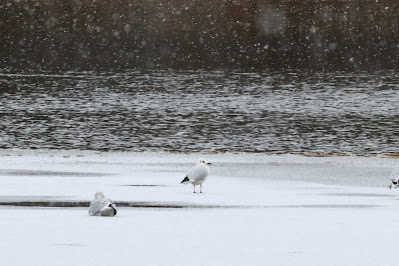It was a day for gulls, that’s for sure. I had two target gulls and succeeded in finding one, plus a bunch of others, during my search.
1: Bonaparte’s 2: Ring-billed 3: Herring 4: Iceland 5: Little 6: Black-headed
Missing was Common Gull. Turned out it was the least common one of the day. It used to be the Mew Gull, however the western North American population was split from the Eurasian eastern population. The newly named Common Gull sticks to the northeast coast of North America and one has been seen on a semi-regular basis in a parking lot in Pictou County, Nova Scotia. The Black-headed Gulls are more traditional and are on the ice in a waterway leading out to the Gulf of St. Lawrence.
I drove up there the previous evening, in pouring rain, and stayed in New Glasgow. I was up early and driving around the different haunts for the Black-headed Gull and finally stopped at a spot over a bridge, where I could see lots of gulls hanging out. There was a bit of a hill leading down to a little bridge. I hit a dark patch of ice under the snow. I went flat on my back, bashing my right elbow against the ice. I saved my camera, most importantly, but I lay there terrified that I may not be able to get up. Luckily, if in a bad way, I could have had my Apple Watch call for help.
For reference purposes, here is what it may have looked like, as portrayed by Jack Black in The Big Year:
Once I picked myself up and dusted off the snow and embarrassment, I started scanning for gulls. It turned out that the Black-headed Gulls couldn’t even be seen from the bridge just beyond where I fell. There were plenty of Boneaparte’s and even a Little Gull that I saw long enough in flight to see its darker underwing. And there were lots of ducks too. But I had to walk down a slippery wooded trail to the next patch of open water covered in ice to really see the Black-headed Gulls, who don’t even have black heads. During breeding season the “black” heads are dark brown but look black from a distance. In the winter they are white with a black spot. They have reddish orange legs and a reddish beak tipped with black as distinguishing features. I took my walking stick for this part of the path, and it opened up in to a spectacular view of the Gulf of St. Lawrence, to which photos do not do justice.
But on the ice to my left, I was able to find a Black-headed Gull, as well as one in flight. The first time I saw one was in December of my 2012 Big Year, even closer than this, but my last view was through a scope overlooking the Whirlpool Rapids in Niagara Falls. These ones were close enough to see the required field marks, thank you very much and I gingerly made my way back to the car.
Black-headed Gulls, Winter Plumage, note the pink belly…cute:
This morning, on my final day here in Nova Scotia, I went on a trek further south for a couple of what are normally spring migration and summer birds. The first, a Yellow-throated Warbler, was top of my list, as it’s not always guaranteed to be seen easily in Canada, even in migration. It passes through parts of Canada from Lake Ontario to the east coast, but it could take a special trip to see it and since it was only an hour away, in the winter, of all times, I headed to Lunenburg and a suet feeder at a house with the single best Christmas decoration I have ever seen:
The next stop was for the Dickcissel. It is a bit easier to find in summer in Ontario, but also can take a half day to find, unless it shows up at a feeder. I didn’t get one in 2021 so it was good to get another bird that should have been in Mexico months ago. I almost missed it, as it landed at the feeder on Montague St, almost thinking it was a goldfinch from a distance, since it flew off so fast and didn’t return. Luckily I had photographic evidence to assure me I had the right bird!
I was still hoping for the Common Gull to make an appearance so I drove the two hours back to New Glasgow, through a white-out or two, and scanned both the parking lot and the frozen over river for a small gull with an all yellow beak. I saw a variety of Herring Gulls, Ring-billed Gulls and even a Great-black Backed Gull, but by the time they were all chased off by some crows, not a sign of the Common Gull. Here in North America, they really aren’t that common after all.
So, I will be flying back to Toronto tomorrow morning, and driving back to Brantford, where I will spend the next few days getting the typical southern Ontario winter birds and maybe some owls. I have heard there was a Boreal Owl at a local conservation area, so I may spend an hour or two combing that park to see what I can see. Though I did not build up a significant list here in Nova Scotia, I head home with 46 species, many of which were one stop shopping birds, that I will not have to give a second thought to the remaining 361 days this year.










No comments:
Post a Comment